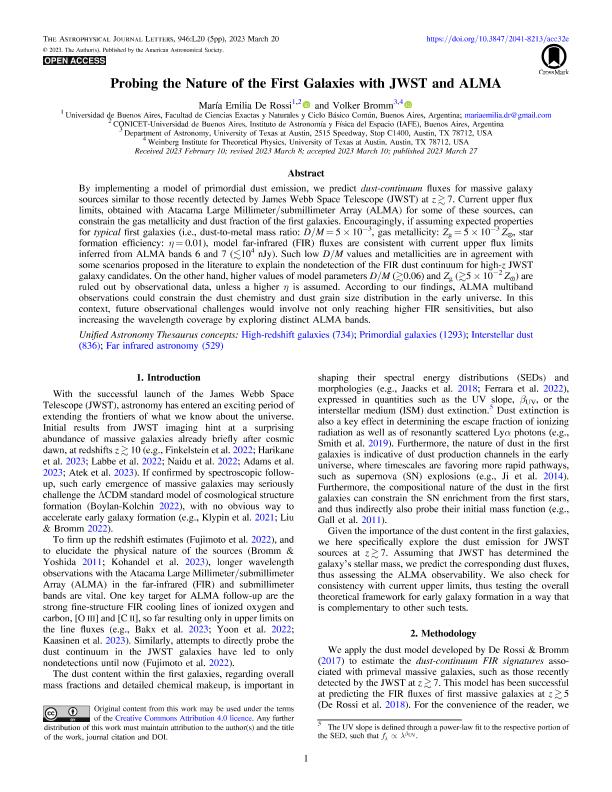Mostrar el registro sencillo del ítem
dc.contributor.author
de Rossi, Maria Emilia

dc.contributor.author
Bromm, Volker
dc.date.available
2024-01-25T12:51:07Z
dc.date.issued
2023-03
dc.identifier.citation
de Rossi, Maria Emilia; Bromm, Volker; Probing the Nature of the First Galaxies with JWST and ALMA; IOP Publishing; Astrophysical Journal Letters; 946; 1; 3-2023; 1-5
dc.identifier.issn
2041-8205
dc.identifier.uri
http://hdl.handle.net/11336/224794
dc.description.abstract
By implementing a model of primordial dust emission, we predict dust-continuum fluxes for massive galaxy sources similar to those recently detected by James Webb Space Telescope (JWST) at z ≳ 7. Current upper flux limits, obtained with Atacama Large Millimeter/submillimeter Array (ALMA) for some of these sources, can constrain the gas metallicity and dust fraction of the first galaxies. Encouragingly, if assuming expected properties for typical first galaxies (i.e., dust-to-metal mass ratio: D/M = 5 × 10−3, gas metallicity: Z g = 5 × 10−3 Z ☉, star formation efficiency: η = 0.01), model far-infrared (FIR) fluxes are consistent with current upper flux limits inferred from ALMA bands 6 and 7 (≲104 nJy). Such low D/M values and metallicities are in agreement with some scenarios proposed in the literature to explain the nondetection of the FIR dust continuum for high-z JWST galaxy candidates. On the other hand, higher values of model parameters D/M (≳0.06) and Z g (≳5 × 10−2 Z ☉) are ruled out by observational data, unless a higher η is assumed. According to our findings, ALMA multiband observations could constrain the dust chemistry and dust grain size distribution in the early universe. In this context, future observational challenges would involve not only reaching higher FIR sensitivities, but also increasing the wavelength coverage by exploring distinct ALMA bands.
dc.format
application/pdf
dc.language.iso
eng
dc.publisher
IOP Publishing

dc.rights
info:eu-repo/semantics/openAccess
dc.rights.uri
https://creativecommons.org/licenses/by-nc-sa/2.5/ar/
dc.subject
HIGH-REDSHIFT GALAXIES
dc.subject
PRIMORDIAL GALAXIES
dc.subject
INTERESTELLAR DUST
dc.subject
FAR INFRARED ASTRONOMY
dc.subject.classification
Astronomía

dc.subject.classification
Ciencias Físicas

dc.subject.classification
CIENCIAS NATURALES Y EXACTAS

dc.title
Probing the Nature of the First Galaxies with JWST and ALMA
dc.type
info:eu-repo/semantics/article
dc.type
info:ar-repo/semantics/artículo
dc.type
info:eu-repo/semantics/publishedVersion
dc.date.updated
2024-01-23T11:58:57Z
dc.identifier.eissn
2041-8213
dc.journal.volume
946
dc.journal.number
1
dc.journal.pagination
1-5
dc.journal.pais
Reino Unido

dc.description.fil
Fil: de Rossi, Maria Emilia. Consejo Nacional de Investigaciones Científicas y Técnicas. Oficina de Coordinación Administrativa Ciudad Universitaria. Instituto de Astronomía y Física del Espacio. - Universidad de Buenos Aires. Facultad de Ciencias Exactas y Naturales. Instituto de Astronomía y Física del Espacio; Argentina
dc.description.fil
Fil: Bromm, Volker. University of Texas at Austin; Estados Unidos
dc.journal.title
Astrophysical Journal Letters
dc.relation.alternativeid
info:eu-repo/semantics/altIdentifier/doi/http://dx.doi.org/10.3847/2041-8213/acc32e
dc.relation.alternativeid
info:eu-repo/semantics/altIdentifier/url/https://iopscience.iop.org/article/10.3847/2041-8213/acc32e
Archivos asociados
